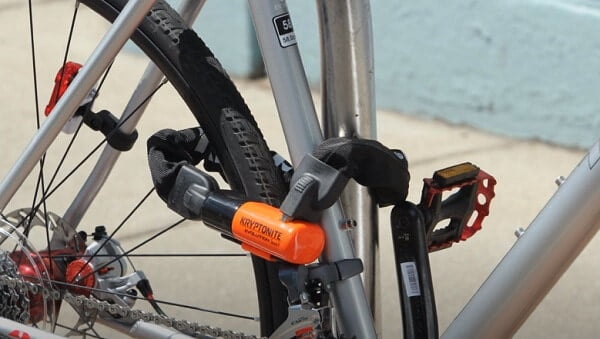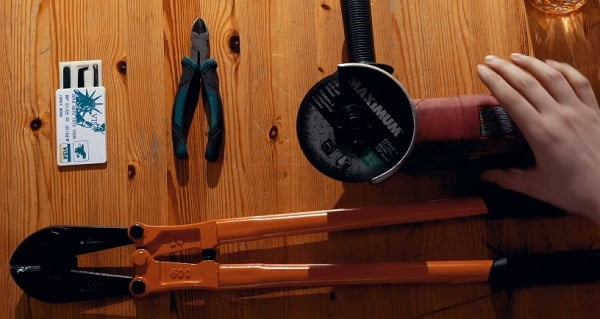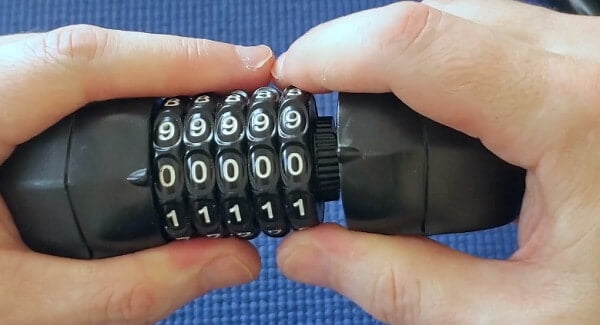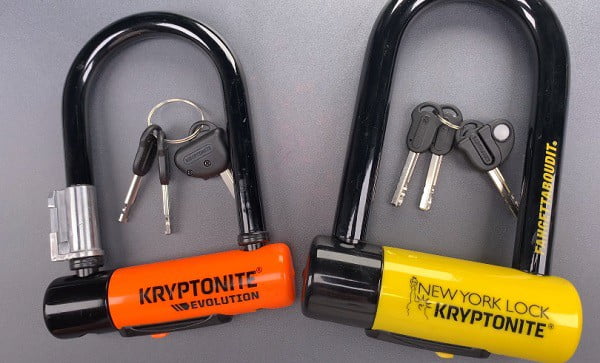When thinking about bike locks, most people look at the type of lock first when considering security. Be it a cable, folding, U/D or a chain type, these would mean nothing without a binding mechanism which is the lock itself.

Locking mechanisms are what closes the loop of your bike security and completes it.
And they are of two types:
- Combination Locks
- Key Locks
Among the two available locking mechanisms, most high-end and highly rated bike locks use key locks with good reason. To put it simply, breaking through a key lock requires substantially more skill than breaking through combination locks.
But that doesn’t mean combination locks are completely useless. They come with their own set of advantages and do have a place in your bike’s security.
In this article, we will be looking at exactly that. The layers of security that each type of locking mechanism offers and the potential vulnerabilities that come with them.
But first, let us take a look at what bike locks in general are up against.
The Tool Arsenal

1. Hands
When we talk about hands we actually mean skill. And like anything, thievery also requires a certain amount of skill, perhaps more than even some legal jobs. A skilled thief will use a combination of talent and knowledge to attempt to break through your security measures. In other words, at a fundamental level the more complicated tour lock is the harder it will be for the thief to overcome it.
2. Lock Picks
A bread and butter tool for most thieves, skilled thieves to be precise, as they require certain talent and knowledge of the lock in order to pick them. Clearly this tool works on key locks only.
3. Cutters
Cutters are small and versatile. Originally meant to cut wires, these tools in the wrong hands can cut through most of the flimsy security measures that many beginners make a mistake of setting up. I am looking at cable locks set up as a primary security measure.
4. Bolt Cutters
The heavy duty, big brother of your typical wire cutters. While they are indeed more powerful and can cut through most cable, armored cable and folding bike locks, the tool itself is pretty bulky and hard to carry around. Not to mention that they will draw the attention of people around them, so thieves generally avoid carrying a bolt cutter with them.
5. Power Tools
The most heavy duty lock breaking tool out there. Thanks to modern battery powered angle cutters, it has now become that much easier to carry one around. These are powerful and can cut through even the most versatile bike lock that you set up on your bike. Even chain and D-locks, under the right conditions of course. However, power tools are contradictory to thieving. They are loud, time consuming on tougher locks, unsafe and like bolt cutters, can be bulky to carry around.
Since our topic today solely involves the locking mechanism of bike locks, our discussion will be focused on the first two weapons of the thieving arsenal that we have just discussed: Skills and Picks.
Combination Locks VS Key Locks
Combination Locks
These locks are convenient enough that you don’t need any keys as long as you remember the code. It is also convenient that you can also share this code with a trusted partner or friend without physically handing them the key.

As you might have already guessed, the lock only opens with a specific combination of letters or numbers. You can heighten the security by simply opting for a combo-lock with more digits.
The more digits it can accommodate the more secure it is, of course. They usually come in 3, 4 or 5 rings of numbers.
Number of Digits
3-digits being the absolute basic and the least secure. There are only 720 unique combinations available and even the unskilled can go through these combinations in a matter of minutes.
4-digits are a bit more standard. Having 10,000 possible combinations, thieves will more than likely opt for other means.
Same goes for the 5-digit combo-lock, boasting to be the most secure.
But I am sure you have noticed the glaring issue with these locks as well, they are convenient for thieves too.
Cheap combo-locks require no tools at all to break through, especially if you keep the combination laying around. There are techniques readily available in public forums and YouTube that show you exactly how to override these locks.
For example:
- Pull on either side of the lock.
- Spin the dial until it feels harder to rotate (kind of locks itself into place), that is the number you are looking for.
- Keep going until all the dials are covered.
It’s that simple! And unfortunately this behavior of the mechanism is like this by design.
However, it is not like such techniques have been ignored by manufacturers. They have taken measures to confuse lock breakers who utilize this method in the form of false gates.
False gates give an impression that you have found the correct combination even when you actually haven’t.
But skillful hands will always find a way around combination locks.
On the bright side however, it is good to know that no one, not even bike thieves with an exceptional sleight of hand, has the patience to fiddle with a lock for longer periods of time.
This type of locking mechanism is mostly found on cable locks (a great combination of low security!) and some cheaper U-Locks.
Key Locks
Instead of relying on luck, let’s look at the mechanism of security that has withstood the test of time: The Lock and Key.
Though not a foolproof method either, but they are indeed a damn sight better.

Types of Key Locks
These key, or tumbler, locking mechanism comes in with two types of keys:
- Flat Key: Quite common, resembles ant regular key. Can come in double sided wafers, however these only give an impression of higher security, in reality these are quite easy to break through with correct skill and tools.
- Round/Cylindrical Key: A uniquely designed key usually found on most chain locks and higher grade U-locks. But don’t let that fool you. They perform similarly to the flat keys, it’s just that the tools needed to break through them may be unique making it harder for thieves, unless they are resourceful.
The only downside of a key lock is inconvenience.
You always have to carry the key around with you. If you happen to lose it you might just have to haul your bike to a mechanic, or the manufacturer even if the lock is of a higher grade. On a positive note, locks like these usually come with a spare key out of the box.
The second inconvenience is of course maintenance. You may require regular lubrication to keep it operating smoothly. Some lower grade key lock mechanisms may all have faulty inner parts. Avoid getting anything cheap for security.
These locking mechanisms are more commonly found on higher grade locks, like U-locks and chain locks.
To Summarize
| Combination Locks | Key Locks |
|---|---|
| + Works with a specific code of 3, 4 or 5 digits | + Works specifically with a designated key |
| - Thieves only require minimum knowledge and skill to break through | + Thieves require both skills and special tools to break through |
| +- Has false gates to deter thieves, but only available in more expensive models | + Has two types of keys: flat and round. Round keys require special tools to crack through. |
| - Usually found on low security cable locks | + Usually found on high security U-locks or chain locks |
Final Words
In the perspective of security, the key locking mechanism is the clear winner.
Its versatility and the layers of security it provides makes it an obvious choice as a primary security measure for your coveted bike.
While not up on the same level of security, the combination locking mechanism can work really well as the secondary security measure for your bike.
That said, the locking mechanism is only one component of the lock itself. There are other important considerations you have to make when security for your bike is involved:
- Never use cable locks as a primary lock. They are cheap and effective, but very insecure. Thus it works well as a secondary lock.
- Keep an eye out for a Sold Secure Rating. Make sure your lock is rated by Sold Secure. Always opt for a Silver rating or above.
Hope we were able to enlighten you on the topic of locking mechanisms of a bike lock. Look forward to our in-depth breakdown of the different types of bike locks out there.
Happy Riding!
Frequently Asked Questions
Q1) How can I make my bike less attractive to thieves?
Ans.: Here are a few logical, and some creative, ways to make you bike seem unappealing to thieves:
Get a sophisticated bike lock. The more unique it is, the harder it will be for thieves to approach your bike.
- Avoid uncrowded spaces. Always park your bike on bike racks with a street view, possibly under a security camera.
- Bring your bike indoors if possible.
- (Optional) ‘Uglify’ your bike. Put some stickers or tape on it to make it seem unattractive.
Q2) Can U-locks be cut?
Ans.: Yes, but it will take some effort and the right conditions.
No lock is completely ‘safe’, even the most premium U-lock can be cut through. But not by just any tools, you will need a industrial grade bolt cutter or a power tool like an angle grinder. Even if you have either of these, it will still take a lot of time to cut through the locks, not to mention unsafe for the thieves.
The right conditions also matter as you will need the proper situation of an uncrowded place (since using heavy tools can be loud) and of course the right angle (without enough space these tools won’t work effectively and the thieves might end up damaging the bike, if not themselves).
